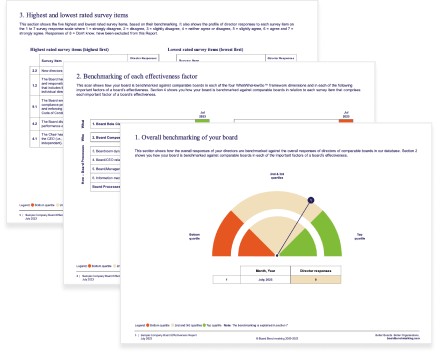A Director Effectiveness Survey is a structured, evidence-based process designed to evaluate and enhance the performance of individual board members. It’s not simply a skills checklist—it goes beyond qualifications and experience to assess the real impact a director has in the boardroom.
This approach typically integrates competencies and behaviours across key dimensions that define a director’s ability to think strategically, engage constructively, exercise sound judgment, and contribute meaningfully to board discussions and decisions. The result is a 360-degree view of each director’s effectiveness—from their own perspective and from the perspectives of their peers.
While most boards appoint directors based on resumes and expertise, an impressive background doesn’t automatically translate to valuable boardroom contribution. Some directors may be highly credentialed yet struggle with collaboration or strategic insight. Others may inadvertently dominate discussions or disengage from critical oversight. A Director Effectiveness Survey is designed to surface these challenges and support constructive development.
Crucially, the survey comes with a benchmarked report, so each director’s results can be understood not just in isolation, but also in comparison to peer groups across sectors, allowing for more meaningful interpretation of strengths and areas for improvement.
Why Boards Should Regularly Undertake a Director Effectiveness Survey
Anchor Board Performance in Human Dynamics
Board performance doesn’t depend solely on structure or governance frameworks—it hinges on the individual people who comprise the board. When directors are thoughtful, engaged, prepared, and collaborative, the board can function at a high level. But when even one director underperforms or disrupts group dynamics, it can compromise the board’s effectiveness.
A Director Effectiveness Survey measures both the competencies and behaviours that drive board success. These include decision-making capabilities, integrity, strategic thinking, influence, active listening, and the ability to engage in constructive challenge. By regularly assessing these factors, boards can identify and reinforce the behaviours that lead to better performance and governance outcomes.
Illuminate Blind Spots and Hidden Weaknesses
One of the most powerful outcomes of a Director Effectiveness Survey is its ability to highlight gaps in self-awareness. Directors often have a clear sense of their own strengths, but feedback from their peers may reveal inconsistencies in how they are perceived.
For example, a director may believe they contribute frequently and constructively, while their colleagues view them as overly dominant or poorly prepared. This insight—when gathered in an objective, anonymous format—can serve as the starting point for meaningful self-reflection and change.
The survey can also reveal underutilised strengths. A director who quietly contributes behind the scenes may be recognised for deep insights or quiet leadership, reinforcing their value to the group.
Support a Culture of Development and Accountability
High-performing boards embrace feedback and accountability. Conducting regular Director Effectiveness Surveys reinforces the board’s commitment to excellence and continual growth. It also provides a structured way for the Chair to engage in development-focused conversations with each director, based on clear data.
These conversations can lead to tangible actions—such as personalised coaching, peer mentoring, or targeted development plans. They also provide opportunities to align expectations, address performance concerns, and recognise exemplary contribution. Over time, this promotes a culture where each director is motivated to improve and where performance is openly discussed and managed.
The DRIVE Framework: A Diagnostic Approach
Some Director Effectiveness Surveys are built around a behavioural and strategic framework—such as the DRIVE Framework—designed specifically for board settings. The DRIVE Framework assesses five key dimensions:
- Direction – The director’s ability to think strategically, assess risk, and offer clear, forward-thinking perspectives.
- Relationships – The quality of the director’s engagement with peers, ability to build trust, and skill in contributing to board cohesion.
- Insight – How deeply a director engages with information, asks critical questions, and offers unique insights.
- Values – A director’s alignment with the board’s ethics, cultural norms, and integrity expectations.
- Execution Oversight – The capacity to follow through, monitor performance, and ensure the board is delivering on its responsibilities.
This framework helps clarify what “effectiveness” looks like in a director—and allows for consistent, nuanced evaluation across a board’s membership.
Choosing the Right Survey Format
Director Effectiveness Surveys can vary in scope and depth. Some boards prefer a concise format, while others invest in more comprehensive assessments depending on their goals, size, and governance maturity. Three common formats include:
Lite or Module-Based Review
This version is ideal for boards seeking a quick check-in or when reviewing individual director performance as part of a broader board evaluation. It typically includes a small number of rating questions and a few open-ended comments focused on strengths and development areas.
Advanced Director Effectiveness Review
This mid-tier version expands the number of competencies and includes detailed peer and self-assessments. It provides a richer view of how directors see themselves and how others experience their contribution. Many medium-sized boards find this format offers the right balance of depth and ease.
Premium Director Effectiveness Review
A comprehensive, in-depth survey suitable for large boards or organisations conducting a full board review. It includes multiple assessment points across each of the key dimensions (such as those in the DRIVE Framework), detailed narrative feedback, and potentially benchmarking data. This format often supports Chair succession planning, director renewal discussions, and long-term development planning.
Benefits of a Director Effectiveness Survey
- Enhanced Self-Awareness: Directors gain a clearer picture of how their behaviour and contributions are perceived.
- Improved Board Dynamics: Insights into interpersonal strengths and challenges help the board operate more cohesively.
- Targeted Development: Results inform coaching, mentoring, and professional development efforts tailored to each director.
- Succession Planning: Feedback can support decisions around director tenure, Chair succession, and board renewal.
- Cultural Reinforcement: Promotes a performance-oriented culture of continuous improvement and mutual accountability.
- Governance Quality: Helps the board deliver on its responsibilities more effectively by ensuring each member is contributing to the best of their ability.
Why Regular Surveys Matter
Director effectiveness is not static. A director’s impact can shift with changing roles, governance challenges, or organisational complexity. That’s why periodic assessments—typically every 12 to 36 months—are essential.
Regular surveys enable the board to:
- Track individual and collective growth over time.
- Respond to changes in strategy, leadership, or external expectations.
- Proactively identify and address emerging performance risks.
- Reinforce a culture of feedback and learning.
In some cases, results from a Director Effectiveness Survey may be integrated into the annual performance cycle, board review, or Chair feedback processes.
Getting Board Agreement
To implement a successful Director Effectiveness Survey, it’s essential to align on:
- Purpose: Are you using the survey for development, succession planning, or performance management?
- Scope: Will you survey only directors or include key executives?
- Confidentiality: Who will see the results, and how will feedback be delivered?
- Timing: Will the survey occur annually, every two years, or tied to the strategic planning cycle?
- Support: Will external facilitators or governance advisers assist with rollout and follow-up?
Having a shared understanding of the intent and process will ensure board buy-in and a more impactful outcome.
Conclusion
A Director Effectiveness Survey is more than a diagnostic tool—it is a catalyst for growth, awareness, and accountability at the highest level of governance. By systematically evaluating the contributions of individual directors, boards can strengthen their culture, improve strategic oversight, and ensure that each member is playing a meaningful role.
When conducted regularly, these surveys help maintain high standards, support leadership development, and foster trust among board members. In an increasingly complex governance landscape, this kind of discipline is not just best practice—it’s essential.
Boards that invest in Director Effectiveness Surveys send a clear message: that excellence starts at the top, and continuous improvement is non-negotiable.
To see what a Director Effectiveness Survey report looks like in practice, you can download a sample report.
If you’d like to discuss how this approach could support your board, you can contact an expert for tailored guidance.



